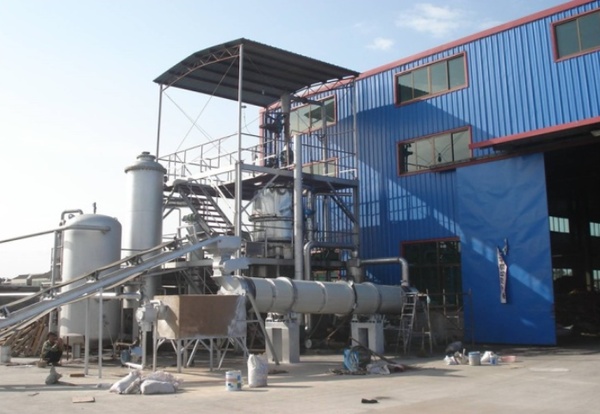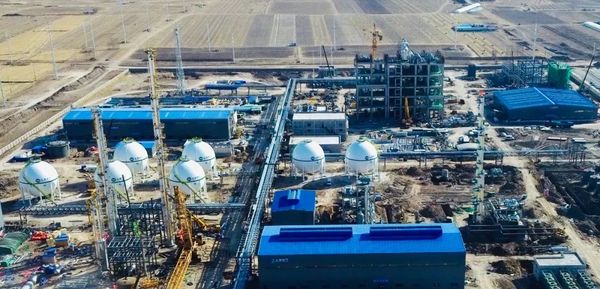Why did China take the lead in successfully developing biomass gasification?
Biomass gasification is the core technology of the sustainable fuel industry. The synthesis gas (H2, CO, CO2) obtained from biomass gasification can be used to produce green methanol, or it can undergo Fischer-Tropsch synthesis to produce sustainable aviation fuel (SAF). Additionally, it can be converted through methanation to produce green LNG. By coupling green electricity and electrolysis to generate green hydrogen, the full utilization of biomass-based green carbon resources can be achieved, maximizing the production capacity of green methanol, SAF, and green LNG.

The Chinese National Energy Administration's Guide to Biogas Utilization Technology Project report indicates that China has a significant advantage in biogas utilization in the field.
1. Biomass gasification and coal gasification share certain similarities, and some technologies and experiences can be mutual. China's rich technical expertise, proprietary knowledge, and talent reserve in coal gasification can facilitate the rapid launch of biomass gasification demonstration projects.
2. In the past few decades, China has developed a complete equipment manufacturing industrial chain in the coal gasification sector. Equipment manufacturing companies are not only proficient in collaborating with biomass gasification technology research and demonstration but also possess cost competitiveness in terms of equipment prices.
3. China is a huge market for biomass gasification technology. Asia Chemical Consulting's "China Green Methanol Project Database" and "China"SAFplanned in the country's database are: * green alcohols (including methanol) for the production of green diesel and gasoline * bioethanol for the production of biofuelsSAFProject exceeds100The rapid development has brought huge market opportunities for suppliers and downstream equipment manufacturing enterprises in the biomass gasification technology industry.
However, we should also recognize that using biomass gasification for large-scale chemical production is a highly challenging new technology. Where exactly does biomass gasification face difficulties?
1. Large-scale and stable supply of biomass raw materials
According to the annual report "Chinese Biomass Gasification Technology and Project" by Ashi Consulting, the large-scale stable supply of biomass feedstock is crucial for the success of biomass gasification projects. Biomass feedstock for gasification includes agricultural waste, forest waste, and urban organic waste, among others.
The biological raw materials account for a large part of the transportation cost and the delivery price bears a large proportion of the transport cost. Therefore, the transport project should be planned rationally to ensure the sufficient supply of biological raw materials within the range of economic transport.
For regions rich in biomass resources but with relatively high costs for wind and solar power, prioritizing green methanol production via all-biomass gasification (without green hydrogen coupling) can effectively control production costs. Conversely, for regions with limited biomass resources but abundant wind and solar power, focusing on projects that combine biomass gasification with green electricity and green hydrogen for methanol production is advantageous, as it can ease the difficulty of sourcing biomass feedstock.
At the same time, large-scale cultivation of energy plants such as giant reed is also expected to become an important feedstock source for biomass gasification.
2. Pretreatment of biomass raw materials
Biomass gasification and coal gasification are similar, categorized into fixed bed gasification, fluidized bed gasification, and bubbling bed gasification, among others. The types and states of the gasification feedstock directly affect the gasification parameters such as gas yield, synthesis gas quality, and carbon conversion rate.
Fixed-bed gasification and fluidized-bed gasification require the bio-based raw materials to be pelletized to ensure that their particle size and moisture content are within the appropriate range.
Some gasification processes in fluidized bed require processing the dried biomass material after gasification, which can be ground into powder as fuel for gasification furnaces.
Stable biomass gasification production requires raw materials to be of uniform size and with a certain energy density to achieve uniform and smooth feeding. Achieving low-energy consumption and high-load stable operation in the pre-processing of biomass gasification raw materials is particularly important.
3. The use of biomass gasification for chemical production lacks operational project experience for reference.
Traditional biological gasification technology in a pressure below atmospheric pressure uses air as an oxidizer, mainly for the purpose of obtaining fuel gas. Although there are many traditional biological gasification furnaces operating at atmospheric pressure, the experience for running them is not yet applied to industrial processes.
Currently, Chinese biomass gasification technology developers are planning a series of demonstration plants that will provide valuable data and operational experience for subsequent commercial-scale biomass gasifiers.
In December 2024, the Shanghai Electric Taonan Wind Power Coupled Biomass Green Methanol Integrated Demonstration Project obtained the ISCC EU certification for biomass storage, biomass treatment, and biomass gasification coupled with green hydrogen production of green methanol, becoming the first green methanol supplier in China to receive full-process ISCC EU certification from biomass collection in the field to green methanol production. The project collects biomass straw, preprocesses it, and then undergoes processes such as gasification, wind power hydrogen coupling, synthesis, and distillation to produce green methanol fuel that meets maritime standards.
On March 20, 2025, Shanghai Electric, CMA CGM Group of France, and SIPG signed the "Long-term Cooperation Framework Agreement on Green Methanol Supply, Transportation, and Bunkering" in Shanghai. This tripartite cooperation focuses on the "production-transportation-bunkering" of green methanol, marking a crucial step forward for Shanghai Electric in responding to China's "dual carbon" strategy, promoting on-site consumption of new energy, and facilitating the green upgrade of the international shipping center in Shanghai.
Based on the protocol, Shanghai Electric will, as the owner of its self-funded investments in the Dalian wind-biogas hybrid project (also known as "Dalian project"), provide long-term green hydrogen fuel for global sea, land, and air transport and logistics solutions, in partnership with Dongfeng Shipbuilding Industry Group, providing key support to France's Dassault Group to complete the addition of green hydrogen to its supply chain at the Dalian port, which is the world's largest container port, through a land-sea-air combined transportation mode, thereby forming a closed-loop circular system of production, transportation, and injection of green hydrogen into the global maritime industry.

The TaoNan project is an important layout by Shanghai Electric in the field of hydrogen-based green fuels, with core technologies and equipment independently developed and manufactured by Shanghai Electric. This move not only realizes the local consumption of new energy and cross-regional resource collaboration but also explores a replicable industrialization model for green methanol. It is a significant practice of Shanghai Electric in serving the national dual carbon strategy and developing new quality productive forces.

The signing of this agreement marks a new stage in the trilateral cooperation in the field of green shipping fuels, providing a "China solution" for the low-carbon transition of global shipping and jointly writing a new chapter of green development. In the future, Shanghai Electric will continue to deepen its core technology breakthroughs in the fields of water electrolysis for hydrogen production, green methanol, green ammonia, and sustainable aviation fuel. It will promote the deep integration of new energy technologies with high-end equipment manufacturing and modern service industries, driving industrial green upgrades with technological innovation, and providing stronger support for promoting China's energy structure transformation and achieving sustainable development.
【Copyright and Disclaimer】The above information is collected and organized by PlastMatch. The copyright belongs to the original author. This article is reprinted for the purpose of providing more information, and it does not imply that PlastMatch endorses the views expressed in the article or guarantees its accuracy. If there are any errors in the source attribution or if your legitimate rights have been infringed, please contact us, and we will promptly correct or remove the content. If other media, websites, or individuals use the aforementioned content, they must clearly indicate the original source and origin of the work and assume legal responsibility on their own.
Most Popular
-

List Released! Mexico Announces 50% Tariff On 1,371 China Product Categories
-

Nissan Cuts Production of New Leaf EV in Half Due to Battery Shortage
-

New Breakthrough in Domestic Adiponitrile! Observing the Rise of China's Nylon Industry Chain from Tianchen Qixiang's Production
-

Dow, Wanhua, Huntsman Intensively Raise Prices! Who Controls the Global MDI Prices?
-

Mexico officially imposes tariffs on 1,400 chinese products, with rates up to 50%






